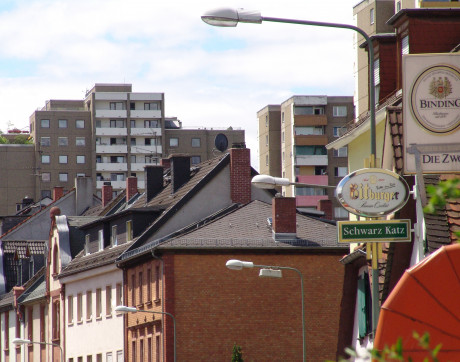"Gehören Großwohnsiedlungen zur europäischen Stadt?"
Ja! 58%
Nein! 42%

Großsiedlungen haben weder in der Außenwahrnehmung noch im Fachdiskurs einen guten Ruf. Das erstaunt, denn an ihrem Bau in der Nachkriegszeit haben sich weltweit bekannte und renommierte Architekten beteiligt – Walter Gropius genauso wie Ernst May, O.M. Ungers, Candilis Woods, Peter und Alison Smithson, ...
Für viele aber sind Großsiedlungen ein Synonym für das Scheitern des modernen Städtebaus, gar einer ganzen sozialpolitischen Grundhaltung. Als anonyme Problemviertel an der Peripherie, die aufgrund ihrer Maßstäblichkeit Planer vor schier unlösbare Aufgaben stellen, werden sie oft und mit Berechtigung als Sorgenkinder der Stadtentwicklung gesehen. Sie gelten als das Gegenteil der europäischen Stadt, dem seit Jahrzehnten vorherrschenden Leitbild im Städtebaudiskurs.
Dabei stellen sie beträchtliche Reserven auf dem Wohnungsmarkt dar und sind Heimat für viele Menschen, die gerne darin leben. Manche ziehen sogar wieder in ihre Siedlungen zurück – auch wenn dies von außen selten zur Kenntnis genommen wird. Für ihre Bewohner scheinen Großsiedlungen also durchaus Qualitäten und Potenziale zu bieten.
Natürlich wird keiner wieder so wie damals bauen wollen und sicher muss differenziert werden zwischen unterschiedlichen Modellen und Entstehungsbedingungen der Siedlungen. Das heißt aber nicht, dass diese Siedlungen keinen baukulturellen Wert haben.
Sie gehören zur Geschichte unserer Städte. Sind sie als Ausdruck sozialpolitischer Ideale der Nachkriegsgeneration nicht Teil unserer kulturellen Identität, eine Form des emanzipatorischen Versprechens, das die Basis für eine funktionierende Demokratie legte? Diese ließen sich durch Abriss genauso wenig löschen wie zum Beispiel die DDR-Vergangenheit dadurch verschwunden ist, dass der Palast der Republik abgerissen wurde.
Vielleicht haben Großsiedlungen nur noch nicht das Alter erreicht, das üblicherweise nötig ist, bis Vergangenes ins Interesse einer Generation tritt, die mit zeitlichem Abstand einen neuen Blick darauf wirft. So wurde auch erst in den 1970er Jahren erkannt, welch hohen Wert die gründerzeitliche Wohnbebauung für die Innenstädte hat.
Aber was würde es für den Umgang mit diesem Teil unserer Stadtbaugeschichte bedeuten, wenn man ihn als Teil unserer kulturellen Identität anerkennt? Wenn man Großwohnsiedlungen nicht mehr als a priori defizitär, sondern als Stadtteile mit eigener Qualität ansieht? Macht man es sich nicht vor allem einfach, wenn dieser Wert nicht zu hoch angesetzt wird, weil dann so manch schwierige Diskussion mit Abriss abgekürzt werden kann? Hinter solchen Fragen steht die grundsätzliche über das Stadtverständnis, mit dem wir diesem Erbe begegnen wollen: Gehören Großwohnsiedlungen zur europäischen Stadt?
Gastredakteure dieser Debatte sind Maren Harnack (FH Frankfurt) und Christian Holl (frei04 publizistik, Stuttgart).
Jein ...
Ja ...
Ja ...
Ja ...
Ja ...
Nein ...
Ja ...
Ja ...
Ja ...
Ja ...

Nein ...
Nein ...
Jein ...
Ja ...
Ja ...
Ja ...
Ja ...
Ja ...

Ja ...
Jein ...
A problem with the term ‘large housing estate’, or even just ‘estate’, is that its meaning is often reduced to images and stories of apocalyptic inner city deprivation. However, the diversity of large housing estates is striking, for example in terms of their architecture, condition, community and social stability. In reality, there are some large estates in London that are widely considered a success. The most obvious of these is the Barbican Estate, which was designed by architects Chamberlin, Powell and Bon in the 1960s. Therefore, there will always be some large estates that belong to the city since they contribute positively to the material and social fabric, and the housing stock.
The question is more complex for large estates whose contribution to the city is more ambiguous. Undoubtedly these places are home to many residents, a point that should not be easily dismissed because of the powerful attachments, emotions and memories involved in home. Some residents enjoy the relationships they have made over the years and the comparatively inexpensive rents. In high-rise estates some also enjoy the benefits of high living, such as the natural light and the view. However, it would be inaccurate to suggest that problems on these estates are just urban myth. Other residents were never fully able to make home because of poor design and construction, deteriorating material environments, anti-social behavior and fear of crime.
So do these more ambiguous estates belong to the city? In an ideal world this would be answered by the residents who live there, rather than by policy makers, architects and academics. However, I suspect the responses would be diverse. Attached to the architecture, some residents would want their buildings refurbished. Others would want them knocked down and new neighbourhoods built that are smaller in scale and have more vibrant street life. The majority want to remain in the same inner city locations they call home. So the simple solution is to refurbish some buildings on large estates, which would also preserve a type of mass architecture that is important in the history of housing. But the remaining buildings should be demolished and new homes built for residents who want something different.
However, in London this is not what is happening. Arguing that they do not have the money to finance such plans, some policy makers turn to private developers or housing associations that demolish the estates and build a high proportion of new homes for the private market. The existing residents are displaced. So the issue becomes not just what housing designs belong to the city, but, of course, what ideas and values belong to the city? This is an urgent matter since large estates in prime inner city locations are being demolished and many residents are faced with uncertain futures.
Richard Baxter studierte Geografie am King’s College in London. 2008 wurde er mit einer Arbeit zum Leben in Hochhäusern promoviert. Zur Zeit ist er Fellow am Centre for Studies of Home am Queen Mary College in London.
3
0
0


